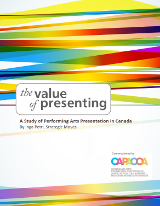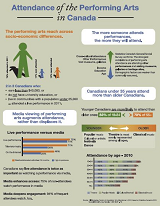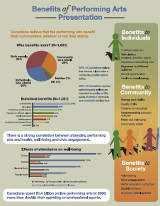1. Arts and cultural research has confirmed time and again that the performing arts sector is not a zero-sum field. Rather, Canadians become ever more likely to attend based on prior attendance at cultural events and performances. These behaviours are strong predictors of attendance while basic demographic factors are much weaker. That means, competition in the performing arts is not other performing arts organizations but rather all the other ways people spent their leisure and entertainment funds. Community-wide, true partnerships should become the rule not the exception in the performing arts.
2. I have a growing body of work that recognizes that performing arts are not only a show on a stage, but that all surrounding aspects contribute to the audience experience either positively or negatively. It is about full experience design.
This graphic
represents key elements of the audience's arts experience that can and should be fully
designed. All have the power to make or break the audience experience, put up
barriers to it or enhance it.
It means applying
end-to-end design thinking including all the ways in which audience members can
amplify the arts organization’s message and reach among their own networks.
Pricing and packaging are aspects that are often taken for granted
due to a persistent belief that the arts do not suffer from sticker shock; that if someone
really wants to see a show they make it happen. Well, price elasticity is real
in the arts, too. The higher the price the fewer people will consider
attending. Therefore, considerations should be given to how to price shows that
are not expected to sell out at a given price point or that are not selling out
despite seemingly well-founded expectations of that. Each of these aspects merits full consideration in your planning and in your evaluations afterwards.
3. Another important idea is that marketing materials are designed for specific purposes to address where a member of the target audience is at in the purchase decision process. Arts marketers need to use the full array of tools in research and evaluation to see how their marketing programs are creating the desired response or not.
An arts marketer's job is not merely to sell the workhorses of the performing arts - anything by Beethoven and Mozart, Nutcracker and Swan Lake, Shakespeare - but indeed to lead larger and larger audiences to contemporary, current live professional performing arts experiences that they don't already know.
To do this requires the integrated use of contemporary marketing strategies and tactics. It is about compelling storytelling, co-creating meaning, and making research on events and purchase of tickets easy and immediate. The increasing integration of services like Youtube, Facebook, Twitter with both desktops and mobile devices and within websites creates new dynamics between organizations and their audiences. this is a good thing.
To do this requires the integrated use of contemporary marketing strategies and tactics. It is about compelling storytelling, co-creating meaning, and making research on events and purchase of tickets easy and immediate. The increasing integration of services like Youtube, Facebook, Twitter with both desktops and mobile devices and within websites creates new dynamics between organizations and their audiences. this is a good thing.
Today, website pages can be shared with a
push of a single button to a user’s social media universe (Brookside’s site
does this well) and it can raise awareness, start conversations or elicit sales
through their social networks. Similarly, organizations are cross-linking their
web sites and social media presence to provide a seamless user experience,
going where users are.
This mind-set approach makes clear that an organization’s brand is more than
a logo applied consistently. it is how it behaves and interacts with current and potential customers. Or perhaps it reaches even further: it is an entire eco-system's way of being and
interacting in the world - and how the sector (and the communities it inhabits) thrives will depend on this concerted action.










